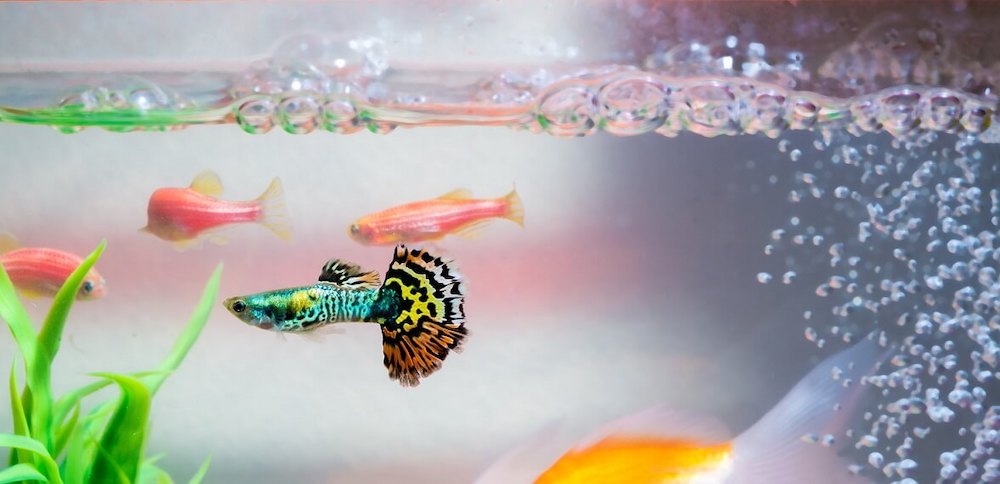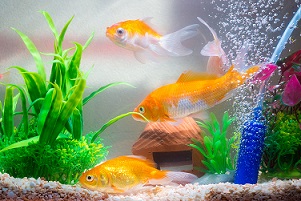
When you go shopping to make your aquarium a better place for your fish, the air pump is one item that you should put on your checklist. Not a few people have decided that it is an essential addition to their tank — you should give it a thought.
The central component of a fish’s life is the quality of oxygen it gets. An air pump massively improves the air quality in a fish tank and works as a great back up if there should be a power outage.
The Quietest Air Pump
The most on-demand factor when it comes to air pumps is how much noise they make. Most people want to keep their fish where they see them often. The necessitates that the pump is quiet and does not cause other disturbances.
The source of noise in an air pump is usually a rubber diaphragm. The thin layer vibrates because of an electromagnet. At specific frequencies of vibration, it gives out a humming noise. But this is not a cause for concern, as many pumps offer a quieter functionality at a reasonable price.
We did the groundwork for you and looked at some reliable pumps in the market today. We rated the following pumps based on their durability, noise levels, and efficiency. Here is what we found.
1) Tetra Whisper Easy to Use Air Pump for Aquariums
Tetra makes some of the most powerful pumps available in the market. Their high power makes them suitable for deep tanks and tanks with many air stones.
These pumps are available for tanks of various size ranges, those as small as 10 gallons to as large as 100 gallons. It comes with a patented design, which is a dome shape with sound dampening chambers. Its design lends it the advantage of minimal turbulence, resulting in smooth and quiet air production.
The quiet design enhances by its wide rubber feet, which flatten the sound frequencies. As a result, the soundwaves do not reverberate on hitting the furniture present in the room and give way to little or no sound-producing vibrations. It will thus cause no disturbance even in the most active and full rooms.
Pros:
- It is inexpensive and affordable.
- If you place it on a solid firm surface, there is no disturbance from the noise.
- The rubber feet and dome design are effective at minimizing noise.
- It has good balance features.
- Ideal for smaller aquariums.
- It comes with an air valve, which prevents water from damaging the pump.
Cons:
- You have to buy your tube for the air pump.
- It requires frequent replacement, at about every two years.
- The airflow is constant and not adjustable.
2) Mylivell Quietest Aquarium Air Pump
The Mylivell pump is unique in its design and operation. It hardly has any competition for these factors in the market. Because it does not have a shaft or a motor or any electromagnetic system, it is extra quiet. The lack of moving parts makes it lightweight, less prone to accidents, and gives it long shelf life.
How does it work without the electromagnet? It drives by piezoelectricity , a thin ceramic plate that layer that creates a wind current. The design of Mylivell allows it to be very small and delightfully with the shape of a sting-ray fish.
The quietness of the machine cannot exaggerate. You have to place your ear on the device to hear anything. Not just that, the design allows for an extremely minimal power consumption of 1 Watt for a reasonable flow rate of 240ml/min.
This pump also comes in size variations, one for 13 gallons tanks and the other for larger, 40 gallons tanks. Its installation process is intuitive and straightforward — no worries for the installation.
It comes with a tube, which lets you use the device straight from the box without having to search for any other accessories. It does not have a check valve.
Pros:
- Easy self-setup.
- Contains a tube and an air stone.
- Two options of color, black and white.
- Extremely quiet.
- Lightweight occupies less space and looks good.
- Ideal for small tanks.
- Long lasting.
- Bubbles are very tiny and fine.
Cons:
- It can only connect to one device at a time.
- Power cord is only 3 feet long.
- Does not come with a check valve.
- One needs the effort to attach the suction cup.
3) Hygger Quiet High Output 10W Aquarium Air Pump
The Hygger pump’s design is to cater to medium to large aquariums for both saltwater and freshwater. Although the pump is very quiet, it vibrates with a palpable feel.
Since it is suitable for larger tanks, it drives by a power of 10W and can aerate tanks from 30 to 600 gallons. That is quite some range of operation! Because of its obvious large power and capacity, the pump is rather unsuitable for smaller than 30 gallons tanks.
The make of the pump includes a bearingless motor, powered through a series of magnetic bearings. They cause relatively low vibrations and noise. The pump itself has two outlets but lacks a tube. You have to supplement it with a 4mm tube to connect the pump to other devices like the air stone or the bubble generator.
The Hygger air pump is convenient if you have more than one aquarium because it comes with two air outlets that can provide oxygen to one or more aquariums simultaneously. You can also assemble them in one aquarium to deliver more bubbles based on your requirements. However, you will need to buy a 4mm air tube to connect the pump to the air stones or bubbler.
The pump is also very quiet in its operation and lasts a long time.
Pros:
- It is an effective pump for maintaining oxygen levels.
- It is quiet.
- Aquarist can use it for multiple tanks at the same time.
- It comes in stainless steel insulation, which further reduces noise.
Cons:
- As compared to other pumps, it is not long-lasting.
- The airflow is constant and cannot be adjusted.
- It is louder than its smaller counterparts.
- It is pricier than other pumps.
Buyer’s Guide: What is an Aquarium Air Pump?
An air pump does what its name suggests. An electric device pumps air into your aquarium and keeps it fresh. The pump pulls air from the outside, displaces some water, and pushes air into the water, visible through bubbles. You might have also seen some drive air-powered devices such as air stones, bubble décor, and sponge filters.
The bubbles generated from displacing the water create a current, push the carbon dioxide to the top, and oxygen into the water volume. This bubble keeps the water full of oxygen that the fish can then inhale.
For the air pumps to grasp fresh air, they need to be kept outside of your tank and deliver air through a tube called the airline tubing. It is vital to keep your air pumps dry since electric devices are usually not waterproof.
The aquarist also must keep the pump above the water level to stop water from damaging the pump. You can also use a check valve to prevent water flow into the pump if you must position it lower than the water level.
Air pumps are effective in both freshwater and saltwater tanks.
Why Use an Air Pump?
The air pump is not a must. That is to say, your water plants and fish will continue to receive oxygen even if you don’t pump it additionally. However, having a pump can improve the level of oxygen in the water and helps with its circulation throughout the tank, thus keeping the water fresh and flowing.
If you already have a HOB filter or a canister filter, you don’t need to supplement it with an air pump. They already cause turbulence on the water surface and make it possible to absorb more oxygen.
Why do you need an air pump? Read on.
1) To Increase The Level of Oxygen in Your Tank
Life thrives where there is abundant oxygen. Your fish will be grateful to you if you supply them with additional oxygen to supplement the natural levels. Only the water surface is exposed to oxygen at the natural level, which is the source of oxygen for your water. With a pump, there is a dramatic increase in the natural levels of oxygen.
In hot weather, such as in tropical areas or summers, this can be a valuable addition to your aquarium. As temperatures rise, oxygen escapes faster into the air, and its level in the aquarium falls rapidly. During such times, the pump can act as a savior.
Adding a pump will ensure that the fish always have adequate amounts of oxygen to breathe free.
2) To Enhance Water Circulation
Like in the natural world, many processes happen in your aquarium as water circulates from top to bottom. For example, the water full of carbon dioxide at the bottom absorbs oxygen when it comes to the top.
In smaller tanks, filters automatically take care of the circulation process. However, when it comes to larger tanks, you might have to supplement the process with an air pump.
Increased water movement in your water help to promote other internal processes such as:
- Temperature regulation
- Exchange of oxygen and carbon dioxide
- Natural filtration process
- Simulation of natural currents for the fish like in the real world
3) As a Decorative

Bubbles in the water make it look livelier. They add an aesthetic and natural sense to the aquarium. Air pumps take very well to air stones, an underwater decorative that generates a mild fizz with bubbles.
4) To Supplement Your Filter
An air pump may be optional, but a filter is not. There are certain types of filters, which need an air pump to function well. Additionally, some protein skimmers in saltwater, spin wheel decorative objects, or other deco that have moving parts depend necessarily on air pumps to filters.
Conclusion
An aquarium pump is optional, and it does add to the noise in the room. However, equipping your aquarium with one is highly recommended for the health of your fish. Therefore, you must choose a balance between the price, noise levels, and ease of use. You may notice that some pumps have a more uniform and smooth noise than others, loud and annoying. This article should help you get started with your research on the most suitable air pump for your needs and the needs of your fish!











